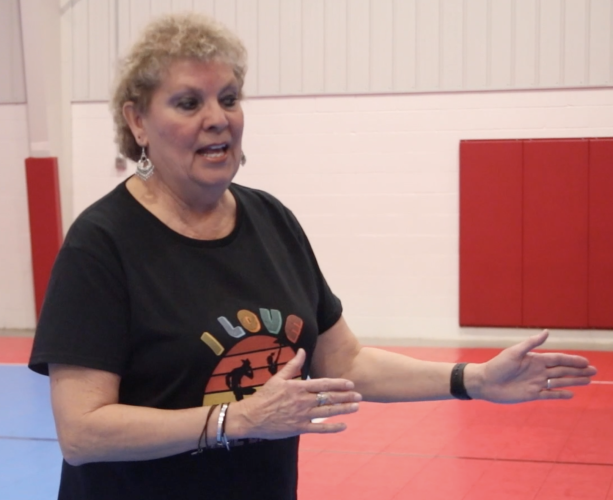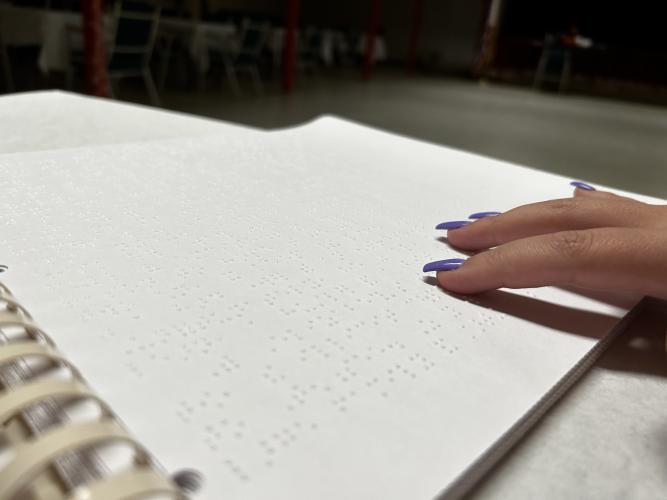Winsett helps shine light on
shortage of Braille translators
At the bottom of every email Crawford resident Debbie Winsett sends, she includes a quote from Helen Keller’s book “Light in My Darkness”: “There is no better way to thank God for your sight than by giving a helping hand to someone in the dark.”
By taking words on a page and converting them to lifted cells, Winsett works with schools in the county and around the U.S. to make textbooks accessible to students who are visually impaired.
These students have long relied on Braille as an essential tool for reading and writing, but the shortage of trained Braille teachers and transcribers has raised concerns about the future of this skill.
According to the National Federation of the Blind, fewer than 10% of blind people in the U.S. read Braille.
With the number of Braille learners, readers and transcribers dwindling, it begs the question: What other tools are available and how important is Braille?
Underlying issues
The shortage of Braille teachers and transcribers is due, in part, to the fact that these professions are not well known. Many don’t consider it as a potential career path, according to the NFB.
The only way to be certified is through the Library of Congress.
“It took me two years to get my transcriber certification through the Library of Congress. Then, I had to do another one in 2015, they went to what’s called UEB (Unified English Braille),” Winsett said. “They changed a lot of it, and I had to take another course and another test.”
The NFB reported there was an overwhelming shortage of Braille teachers, with 6,700 teachers serving approximately 93,600 students.
This means many students who are visually impaired or blind are not receiving the instruction they need to learn Braille, and they are missing out on the benefits that come with being able to read and write independently.
The Individuals with Disabilities Education Act, known as IDEA, has allowed for significant progress in meeting national goals for developing and implementing effective programs and services for early intervention, special education and related services.
Before this act was put into place, students were often denied access to education.
“In 1970, U.S. schools educated only one in five children with disabilities, and many states had laws excluding certain students, including children who were deaf, blind, emotionally disturbed or had an intellectual disability,” according to the IDEA website.
In the 2020-2021 school year, 7.5 million children around the country with disabilities were met with special education and other services designated to meet their specific needs.
“Long time ago, students who were visually impaired, no matter where they lived, got put on a bus every Sunday afternoon, buses would come and pick them up. Every state has one location. Ours is in Macon, Georgia,” Winsett said. “Well, then the law passed years ago saying if you live in a county and you don't want your kid to be hauled off like that, then the school in your area has to provide for you.”
Creating Braille
Winsett, who was born in Savannah, started her career as a paraprofessional in the Oglethorpe County School System in 2001.
She began working with her first blind student when that person was in sixth grade, which inspired Winsett to learn Braille. After writing and rewriting books to learn the process, she then went through the two-year course to become certified.
Winsett received her Braille Transcriber certification from the Library of Congress in 2010. She didn’t know, however, that she would be transcribing learning materials for students all across the country due to the lack of certified Braille transcribers.
The year following her first student’s graduation, she started working with her second student in Oglethorpe from ninth to 12th grades. When graduating, Winsett walked across the stage with her student.
Winsett has worked in Oglethorpe and Hall counties, and has worked remotely in Monroe and Canton, Georgia, a school district in Virginia and in the Glendale district in California. She now works remotely for the Riverside district in California.
“Even though I do not know a lot of these students, to me, they're almost like they're mine, and I want them to have everything that the sighted student has,” Winsett said.
During her time as a Braille transcriber, she has transcribed about 27 different subjects, stretching from Spanish I and II to statistics.
As someone who doesn’t speak Spanish fluently, Winsett said the process of transcribing Spanish is different than other subjects and takes hours to complete.
“I have to transcribe it in what's called grade one. Grade one is every letter,” she said. “Then I have to go back, and I have to do all of the accent marks. And I probably proofread that stuff probably five times.”
Winsett said transcribing for the different grade levels requires a different approach.
When transcribing early grades, the transcription requires every letter to be written, but once the student starts to learn contractions within their schoolwork, she’s able to include those in the transcribed work.
“They do these contractions when they get to that age (11),” Winsett said. “The true ABCs and spelling words, the way that we do it, is for the beginners. In first grade, we start teaching the contractions; I mean, we don't waste time with that.”
The Braille transcriber shortage
Many people who are blind now use text-to-speech technology, which can read books, emails and other documents aloud.
This technology is often faster and more convenient than reading Braille. Additionally, the education system has shifted away from teaching Braille, and many blind students are now taught to rely solely on technology.
School resources often default to copy and pasting text into automatic online transcribers, but there are limitations to these tools. For instance, they often are unable to distinguish when paragraphs begin and end.
Jana Hertz, president of the National Braille Association, said there is a severe shortage in Braille transcribers, also known as TVIs or TSVIs (teachers for students with visual impairments).
Hertz said she had a college student from the University of California who studied law and reached out to her due to being unable to read the documents that an uncertified employee put into a Braille translation program.
“All of her law briefs were strung into one document. She couldn't tell where one ended and one began,” Hertz said. “She contacted me and she said, ‘Jana, I know I'm moved on (from school where Hertz teaches and transcribes), but I need help.’”
The shortage of Braille transcribers is also a problem. Transcribers are responsible for converting printed materials into Braille, which is essential for blind people to access a wide range of information.
There are not enough transcribers to meet the demand, which means that blind people often have to wait a long time to receive materials in Braille. This can be especially frustrating for students who need to access textbooks and other educational materials in a timely manner.
Addressing the shortages
Despite these challenges, there are some efforts underway to address the shortage of Braille teachers and transcribers.
Winsett is a volunteer with Be My Eyes, a mobile app that aims to help visually impaired and blind people identify objects and assist with everyday tasks.
Sighted volunteers sign up and receive one-way video, but two-way audio calls are based on time zone and language from blind or visually impaired users looking for assistance in tasks such as identifying the color of a shirt or navigating unfamiliar surroundings.
Braille organizations across the nation are collaborating to offer more appealing transcriber programs.
The NBA offers certification programs for both teachers and transcribers, and there are also programs that provide financial support for people who want to pursue these careers.
Kimberly Hutter, a technical assistance specialist in the Technical Assistance for Excellence in Special Education department at Utah State University, works with stakeholders on a pilot program rolling out this month.
The program will follow a cohort model which will include a virtual classroom on Canvas where participants will go through lessons provided by the NFB with two master level trainers.
Participants will go through the course in a group setting, and most importantly, will receive feedback on their assignments in a timely manner.
“You're doing it with a group that we will hopefully see more success with the amount of individuals getting through the program to become certified literary Braille transcribers,” Hutter said.
With efforts at the national level, Hutter believes this program will provide better accessibility to Braille transcriber programs and draw more interest in pursuing a career in the field — including in areas like Oglethorpe County.
“This will give individuals who may be in a rural area, that do have an internet connection, an opportunity to learn a new trade,” Hutter said. “Finding ways to bring in individuals who might not ever have thought of a career, but now can because they have access to this, because we're working on it from different avenues as a collective group.”
Local problems mirrored nationally
The NFB explains that Braille is the only system that allows blind people to read and write independently, and to do both interactively.
Braille usually cannot be curated in an online translator and printed, otherwise sections are often combined and some transcriptions aren’t completely accurate, requiring transcribers to re-do and correct a lot of issues.
Math is one subject that requires a lot of time and patience to transcribe.
“I had a vision teacher tell me one time, ‘You know, we have a program that you can put a lot of that math into,’ and then she says, ‘No Debbie, better yet, you do that math so fast on your own, that program would hold you back.’ But see, I've done it for so long, I just know it, and I mean, I've done trigonometry, geometry, physical science," Winsett said.
She created a game to teach other paraprofessionals and teachers aides basic Braille.
“I did a lot of tactile graphics where we use a lot of puff paint,” Winsett said. “So I might draw a picture with puff paint, I'd still have to maybe Braille words to go outside it to tell them what it was, but I could make pictures by textured paper, by wicky sticks or puff paint.”
Winsett said her turnaround time on assignments is quick now that she has become proficient in literary transcribing.
“I proofread everything. Math, I proof read at least twice, but literary stuff, I can knock that out in no time,” she said.
Along with school subjects, Winsett has also transcribed restaurant menus, wedding invitations, church programs, a test for a visually impaired student at the University of Georgia and a letter for singer Ronnie Milsap.
In the end, Winsett said she just wants any students who are visually impaired or blind to receive opportunities.
“I want them to be able to go to school, to excel in school, to be able to have what every other sighted student has in school, and if they want to go to college, by George, I want them to have everything they need to go to college,” she said.


